Special feature: Tracing international exchange through archaeological sites
Immigrants who brought horses and breeding techniques to Kōzuke
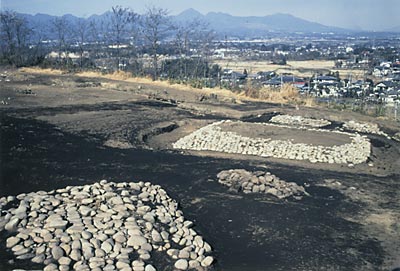
The graves of immigrants? Square mounds at the Kenzaki Nagatoro Nishi Site |

Gold earrings with pendants |
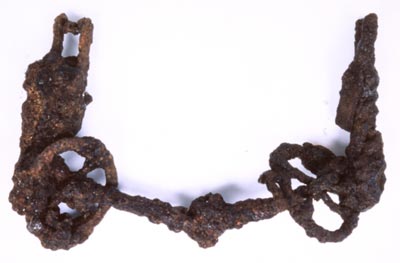
|
Horse bit |
|
| |
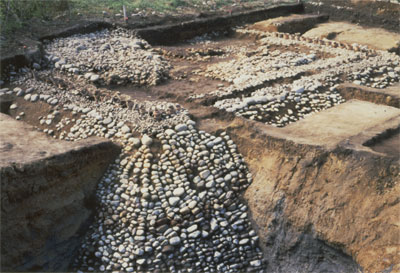
Stone paving at the Shimoshiba Yatsu tomb (upper tier) |
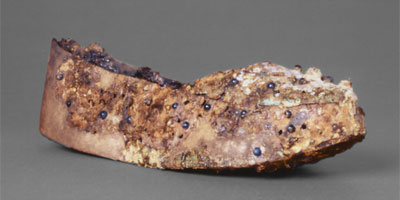
Gilt bronze ornamental shoes |
|
Photos courtesy of Takasaki municipal board of education.
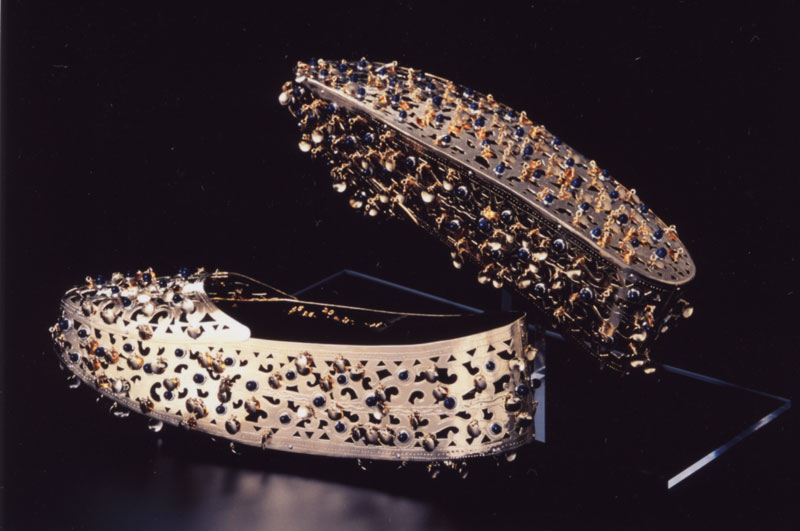
Reconstruction photo courtesy of the Kamitsuke Museum.
| |
Kenzaki Nagatoro Nishi Site, Hamagawa Ashida Kaito III Site, Shimoshiba Yatsu Tomb, Shimoshiba Gotanda Site; Takasaki City, Gunma Prefecture
Clusters of round mounds, square mounds, and stone cairns
Almost a decade ago, an investigation was conducted at the Kenzaki Nagatoro Nishi Site to the south of Mt. Haruna in 1997. The western part of the site was a tomb cluster from the latter half of the fifth century, with a settlement site of the same time period in the eastern part; the tomb cluster consisted of nine or more round tombs forming its core, with three square mounds and five small stone cairns off to the side toward the southeast. Round mounds in this region are the graves of persons of influence, with square mounds thought to belong to persons not central to the social group.
Accessories of gold, people who brought horses with them
From the No. 10 mound, a square tomb, gold earrings with pendants made on the Korean peninsula, and Korean-style terra cotta ware were recovered. A pit in which a horse outfitted with Korean-style equestrian gear was buried was discovered between the round and square mounds. In the settlement, many pit dwellings were found with built-in earthen stoves of the earliest type seen in eastern Japan, and recoveries of Korean-style terra cotta were conspicuous. The occupants of the square mounds are inferred to be immigrants from the Korean peninsula, who were involved with horses.
Sites similar to this one in having square mounds, stone cairns, and terra cotta ware are found widely over the southeastern and southern foothills of Mt. Haruna. The Shimoshiba Yatsu tomb, located near the Hodota tomb group in the city of Takasaki, is a square mound twenty meters on a side, and from the stone compartment surrounding the coffin were found elaborate gilt bronze ornamental shoes, items enjoying great popularity on the Korean peninsula. Here too is evidence for strong ties with the Korean peninsula. At the nearby Shimoshiba Gotanda Site, pottery including Korean-style terra cotta ware, and the traces of ritual using steatite effigies were found.
Hoof prints packed in volcanic ash
Remains of rice paddies buried by an eruption of Mt. Haruna in the early sixth century have been discovered from the same region. At the Hamagawa Ashida Kaito III Site, prints have been left in the paddy surface by the hooves of horses used in agricultural work. Equestrian gear is also found in many tombs of the same period. This is proof for considerable diffusion of horses throughout the region at this time.
It is inferred from the above that in the latter half of the fifth century, immigrants having specialized skills in horse breeding were received in this area, where organized horse breeding was first begun in eastern Japan. There are many sites from the same period in the vicinity of Shijōnawate City in Osaka Prefecture, and in the environs of Iida City in Nagano Prefecture, where horses were raised, and it may be imagined that immigrants involved with horse breeding in the Kōzuke region passed through Shinshū from Kinai, in other words along what would later become the Tōsandō highway. Did the introduction of horses perhaps make such a long-distance overland route possible? (Migishima Kazuo)
